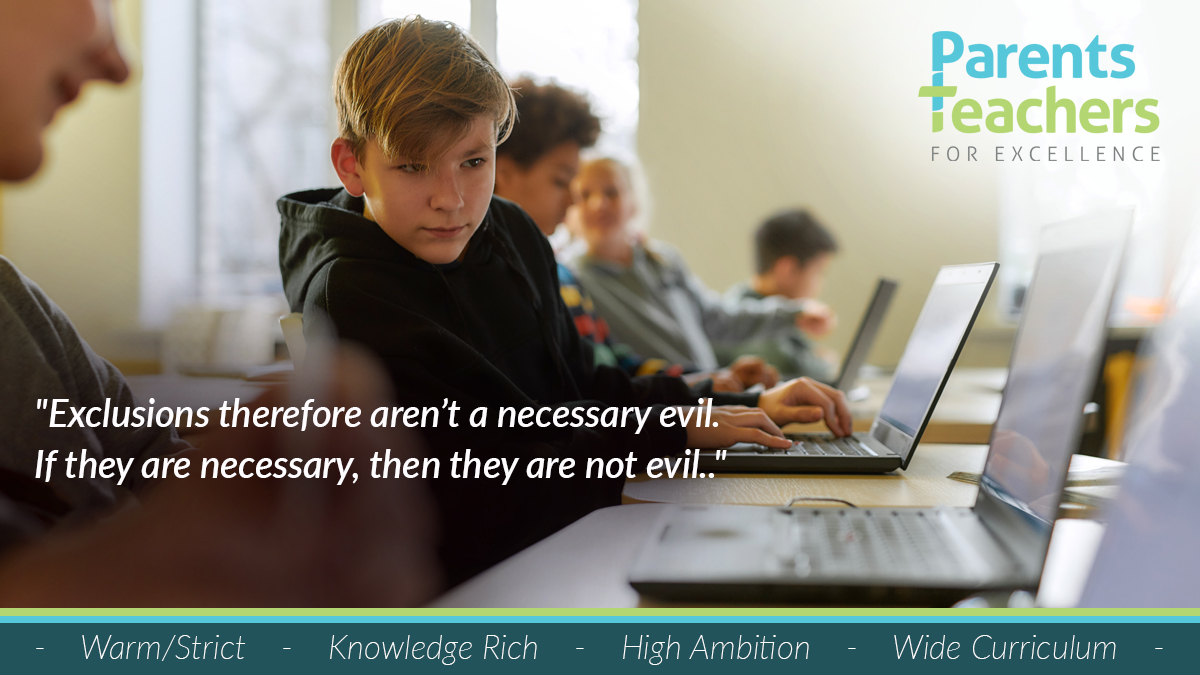Warm/Strict – Exclusions keep schools inclusive
At PTE we believe Warm/Strict approaches are key to a great school culture and the best way to get the most out of, and for, pupils.
If we get the culture right so many other good things happen. Partly this is because far fewer bad things happen to get in the way – fewer minor incidents occur, and of those, fewer escalate and become major incidents. It’s a virtuous circle, and a joy to behold when it happens.
However, schools exist in a world of real people who are not perfect.
Sometimes, despite all possible support, a pupil will persistently make other children unsafe or disrupt learning. Or they will do something so serious or dangerous that the commensurate consequence must go beyond the standard ones, for the good of that pupil and the wider school community.
After all, above anything else, a school must keep its members safe. An unsafe school isn’t a place where anyone should be. It’s also not a place where learning can take place.
And while unsafe or unruly schools are to the detriment of everyone, they most impact upon those who are more vulnerable or who have additional or specific needs in order to properly include them.
If you’re an anxious child, an aggressive or threatening classmate might be the thing that stops you attending school or pushes you into a spiral of despair or depression.
Or if you have a particular need for quiet lessons and to avoid overstimulation, you will be disproportionately affected by someone persistently disrupting a class, or calling out, or hurling abuse at the teacher.
Unsafe schools by definition are not inclusive. Therefore, if we wish to keep our schools inclusive, we must keep them safe and orderly – and so we have to keep in reserve the ability to remove those who would seriously undermine things for everyone else.
Hence the importance of schools being able to temporarily suspend or permanently expel pupils who put the wellbeing and learning of others at serious risk. Being able to exclude – as a last resort – actually makes schools more inclusive places.
Having the power to exclude a child is an essential one for those we entrust to run our schools. Indeed, we cannot have a truly inclusive education system without exclusions for two very important reasons:
- effective use of exclusions keeps schools safe and improves the general standard of behaviour – to the benefit of all, but more vulnerable students the most; and
- exclusions can be the trigger to take poor behaviour seriously, properly address underlying issues and responsibilities, and change things for the better.
For the first point: as above, for a school system to be truly inclusive, those who work and learn in it must feel safe. No school can be safe without effective behaviour systems, and no behaviour system works without an ultimate end point beyond which no one can go without consequence.
In addition, by having such an end point and improving behaviour generally, we actually reduce the number of children who reach and exceed it, and ultimately keep more children in school, making things even more inclusive as a result.
As usual, the Department for Education’s Behaviour Advisor Tom Bennett has said it best:
“Exclusions are needed as a last resort, or the entire system before it chokes. If there is no terminus for extreme persistent misbehaviour, then anything is permitted up to that point too. Exclusions therefore aren’t a necessary evil. If they are necessary, then they are not evil.”
Of course, exclusion isn’t the end point for a child. One would hope that the many interventions undoubtedly attempted before exclusion would have worked, but sometimes it takes the ultimate sanction for things to change. In spite of everything else a school or family does to support a child; it can take a really serious sanction like a fixed-term or permanent exclusion to trigger change.
It can and should be a wakeup call, and the start of something new and positive.
It is only when a child is ready to look at the consequences of their bad behaviour and commit to improve it that they have a decent chance of being genuinely included in the truest sense of the word: welcomed by peers, supported by teachers, and able to get stuck into their learning properly.
Ideally this wouldn’t require an exclusion, but sometimes it does. Preferably pupils can turn things around in time so that they can continue at their current school, but sometimes it might need to be a fresh-start at another place – be that another great school, specialist provision, or pupil referral unit.
Overall, then, carefully used as laid down in law, exclusions do make our school system more inclusive overall. We mustn’t pretend that avoiding exclusions by turning a blind eye to unsafe or unruly behaviour will bring about better inclusion by any meaningful definition.
And we mustn’t assume that exclusions are the end of a child’s education. They are not part of a “school-to-prison” pipeline, but something that often gives a troubled young person the opportunity, space, and support to change things for the better. We remove or artificially reduce its use at their peril.
